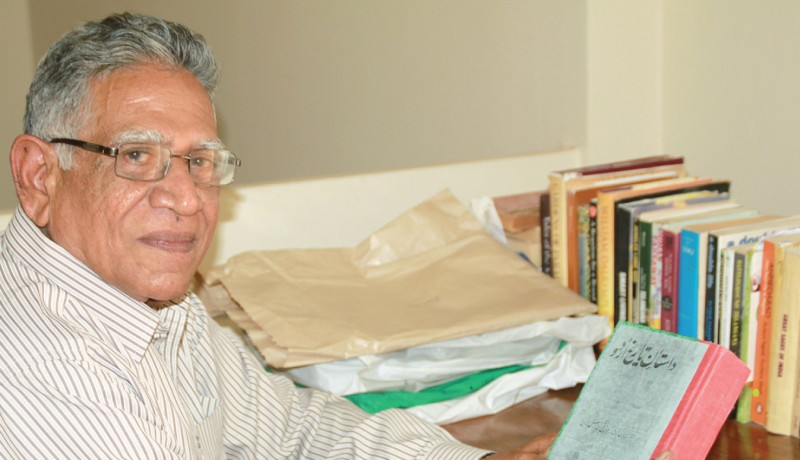
Etcetera

Two years ago, while visiting Nagpur, Upendra Reddy stumbled upon an Urdu book that launched him on an extraordinary journey to translate it to English. The tome, Dastan-e-Tareekh-e-Urdu by Hamid Hasan Quadri, which dated back to 1940, was resting on a shelf in a crumbling bookstore.
When he flipped through the pages, Reddy couldn’t contain his excitement. A connoisseur of Urdu, this 78 year-old Hyderabad resident was lost in the rich, lyrical and nuanced nature of the language. “Dastan-e-Tareekhe-Urdu, which dwells on the history of Urdu, illustrates how the language is an amalgamation of Sanskrit, Pali-Prakrit, Persian, Pushto and Turkish,” he says. “It is a ‘mongrel’ language developed from the many invading conquerors who spoke various tongues.”
Consumed by the book, Reddy spent a year translating it and is now in the final stages of editing. Although not a qualified translator, Reddy hails from the land of the Nawabs and has an extensive engagement with Urdu. He inherited his passion for the language from his father, and can read and write Urdu.
Reddy’s spirit of adventure is mirrored in his rich and varied life experiences. He was born into a jagirdar family and, for the longest time, tended to a 400-acre farm near Jadcherla, a town now located in the state of Telangana, before he moved to Hyderabad in 1991.
He has also tried his hand at politics, and is a treasure trove of knowledge that he has accumulated from reading. On his love for Urdu, he says he studied the language only till Class IV but spoke it at home and at social events, as it was the language of aristocrats. “Although we were basically Telugu speaking, it was customary for men of a certain social standing to speak Urdu and women to speak Telugu.”
On why Dastan-e-Tareekh-e-Urdu is so special to him, Reddy says, “The book tells you how the language took shape across 500 years and how the rough edges were smoothed as it was used more and more. Urdu has evolved into a lyrical language that easily lends itself to a variety of nazm, ghazals and other kinds of literature.”
So, with the help of a friend, 60 year-old Syed Quadri, an accountant by profession and Urdu speaker, Reddy set out to translate Dastan-e-Tareekh-e-Urdu in early 2015. They met every Saturday for a year and pored over the book and reference material. “Syed Quadri is more proficient in Urdu, while I guess I am a little better in English. For both of us, it’s been a labour of love more than anything else,” says Reddy. Although this will be his first major work, he has roped in a reputed publishing house to publish the book as soon as the manuscript is ready.
It would be an understatement to say that this has been an extremely fulfilling journey for Reddy, who discovered many facets of the language that he had only guessed to be true. “I was fascinated by the word ‘ghazal’, which refers to a type of poetry in Urdu that can be set to music and sung. For many years, I had suspected that it had something to do with the fluid movements of a gazelle, the dainty antelope that seems to fly in waves. It turns out that I was right! A few years ago, I found a book that said the word ghazal is derived from gazala, the Persian name for the antelope!”
Reddy has two more projects waiting to be tackled—one is the transcription of the diary which his father maintained from the age of 14. “He writes vividly about the changes that he saw from the 1880s to the time he expired in 1968, when he was 83 years old.” The second is his desire to get back to his collection of short stories. Someday, he hopes to publish that too.
—Shyamola Khanna
Photograph by Shyamola Khanna Featured in Harmony — Celebrate Age Magazine November 2016
Comments are closed.
you may also like to read
-
Cracking the longevity code
Small yet impactful choices can be game-changers, writes Srirekha Pillai At 102, there’s no stopping Chandigarh-based Man Kaur, the world’s….
-
Home, not alone
While a regulatory framework is vital for senior-care facilities, the need of the hour is to develop an ecosystem to….
-
Birthday Girl
Published in a special edition to honour Japanese master storyteller Haruki Murakami’s 70th birthday, Birthday Girl (Penguin; Rs 100; 42….
-
A huge treat for music lovers
Published as the revised and updated second edition, Incomparable Sachin Dev Burman (Blue Pencil; Rs. 599; 470 pages) the authoritative….







